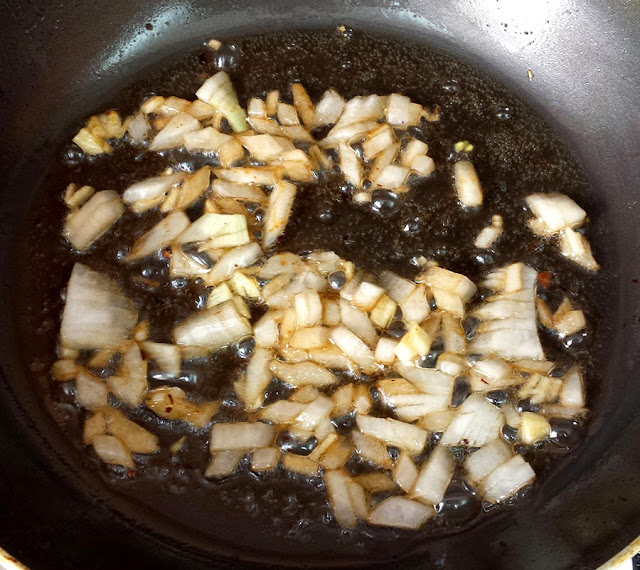Sauce au jus de viande
Tuesday, November 25, 2014Sauce au jus de viande is beef gravy.
Before you start you need to know the names of some things.
Here they are:
Fond - are the browned bits or drippings from meats or vegetables, found on the bottom of a sauté or roasting pan via the Maillard reaction.
Deglazing - is a cooking technique for removing and dissolving browned food residue (the fond) from a pan to make a sauce. The browned residue is due to either the Maillard reaction or caramelization.
Maillard reaction - is a chemical reaction between amino acids and reducing sugars that gives browned foods their desirable flavor. Seared steaks, pan-fried dumplings, breads, and many other foods make use of the effect. It's the browning effect.
Roux - is flour that has been browned in some form of fat, usually oil, but sometimes butter, in equal parts. Some form of roux is used in order to create sauces and gravies - generally the Mother Sauces and derivatives. This type of roux is cooked off only long enough to cook the raw flour, and though there is little to no color, it carries a strong thickening power to the dish, the blond roux. A darker colored roux, or brun roux, acts not only as a thickener, but also adds additional flavor and imparts a deeper, richer color to the dishes where it is used as a base.
Now that you know these names you can start the recipe.
Ingredients
1 tablespoon of olive oil
3 tablespoons of butter
4 tablespoons of all-purpose flour
2 tablespoons of minced shallots or onions
1 teaspoon of minced garlic
1/2 teaspoon of rough chopped fresh thyme
3 cups of beef broth/bouillon
Salt and freshly ground black pepper to taste
Note: if you are making any kind of beef you can sear it with 2 tablespoons of butter and keep the fond that the Maillard reaction created to sauté the onions and garlic. Just remember that if you are searing the meat already salted and peppered you definitely need to watch the salt because your broth is probably already salted. I almost never need to add it. Leave it to the end after you taste the end result.
Directions
The fond
Sear both sides of the beef in olive oil, until you get the Maillard reaction and form a fond. An actual saute pan is better. Nonstick pans don't allow the fond to form properly.
The broth
If you aren't using home made or canned liquid broth you need to mix it firs1 cup of beef broth/bouillon = 1 cup boiling water and 1 teaspoon instant beef bouillon granules/powder (or 1 bouillon cube).
So, boil 3 cups of water and add the 3 teaspoons of beef broth/bouillon (or 3 cubes), mix it well and turn it off.
If you use beef broth that is already salted leave the salt for last because you might not need it.
In a hot frying pan add the olive oil then add the shallots and garlic to sauté. If you have the fond from searing the meat, then add the oil, shallots and garlic straight in and deglaze the fond while you sauté.
When golden add the thyme and the pepper. If you used the fond to sauté, it should look golden brown but not burned.
Drop the sauté in the beef broth/bouillon and mix.
The roux.
Melt the butter in a saucepan and add the flour to create a roux.
Mix 6 to 8 minutes until you have a brun roux (dark brown).
Medium heat is best.
Add the roux to the beef broth and bring it to a boil.
After it starts boiling lower it to a simmer and cook it for about 20 minutes.
Note: If you want it even thicker add a mix of corn starch and water to it and mix until you reach the thickness you want.
Too much will make it gelatinous.
I add 2 tablespoons of corn starch to 1 cup of water and mix until I have no lumps, then add it slowly to my sauce while mixing, giving it time to work so it's not over the thickness limit I want.
But for this gravy I have never needed to thicken it, since that is the roux's job.
If you don't know the difference between a boil and a simmer, here it is:
Rolling boil - cannot dissipate the bubbles when stirring. You should never use rolling boil for protein (it becomes leathery).
Boil - when stirred the bubbles dissipate for a second. Bubbles break in different edges of the pan. Still too much to boil protein.
Simmer - low heat when no bubbles break the surface with lots of steam. Used for slow cooking.
Poach - no bubbles break the surface with very little steam that stays inside the pan walls. It is best heat to boil protein because it keeps the moisture and gets it fully cooked.














0 comments